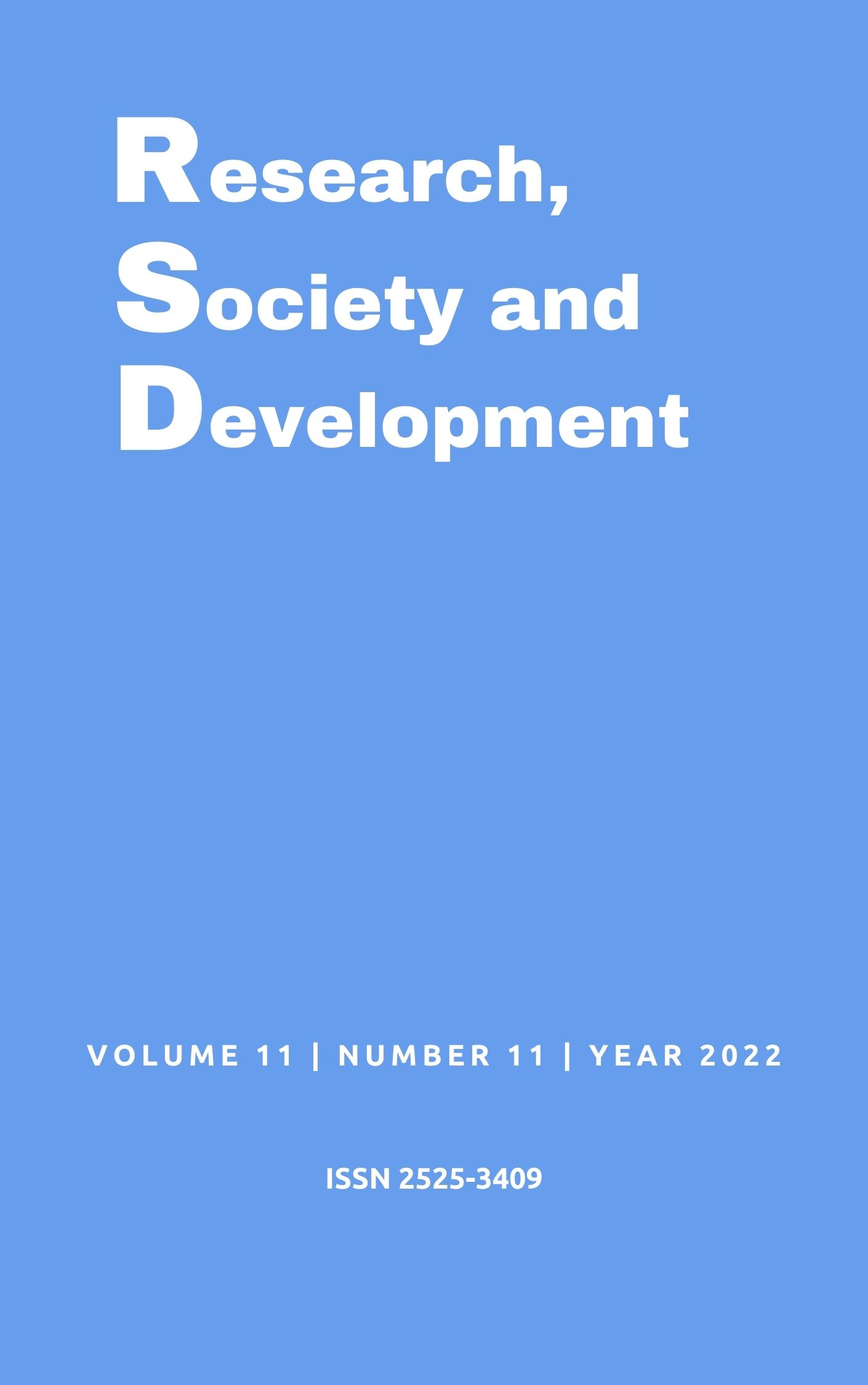Physiological responses of Phaseolus lunatus L. submitted to irrigation with saline water and potassium fertilization
DOI:
https://doi.org/10.33448/rsd-v11i11.33287Keywords:
Electrical conductivity, Fava, Dry matter, Sodicity.Abstract
The objective of this work was to evaluate the development of fava beans (Phaseolus lunatus L.) under different levels of irrigation water salinity and different doses of potassium fertilization. The experiment was carried out at the Federal University of Paraíba, Areia, Paraíba, Brazil. Three electrical conductivities of irrigation water (0, 0.3 and 6.0 dS m-1) and three doses of phosphate fertilization (0, 30 and 60 kg of K2O) were used. The following were analyzed: plant height and number of leaves, fresh mass of the aerial part of the plant, fresh mass of the root, dry mass of the plant and dry mass of the roots. According to the results, it was observed that potassium fertilization induced an increase in the number of leaves, in the treatment with 60 kg ha-1. The increase in sodicity led to a decrease in production at the level of 6 dS m-1. The best bean production was obtained with the dosage of 30 kg ha-1 K2O. Since the increase in the salinity of the irrigation water inhibits the phenological development of the fava bean, as it makes it difficult for the plants to absorb potassium, since this nutrient is essential for the production of phytomass. Thus, it is possible to conclude that saline irrigation water with electrical conductivity of 0.3 and 6.0 dS m-1 inhibits the phenological development of the fava bean. The dose of 30 t ha-1 of potassium favored the increase in the mass of fresh and dry bean matter.
References
Abbasi, H., Jamil, M., Haq, A., Ali, S., Ahmad, R. & Parveen, Z. M. (2016). Salt stress manifestation on plants, mechanism of salt tolerance and potassium role in alleviating it: a review. Zemdirbyste-Agriculture, 103 (2), 229-238.
Brasil. Ministério da Agricultura. 1972. Equipe de pedologia e fertilidade do solo. Divisão de Agrologia - SUDENE. Levantamento exploratório: reconhecimento de solos do estado da Paraíba. (Boletim técnico, 15). Rio de Janeiro: MA/CONTA/USAID/SUDENE.
Campos, A. J. M., Santos, S. M. & Nacarath, I. R. F. F. (2021). Estresse hídrico em plantas: uma revisão. Research, Society and Development , 10 (15), e311101523155-e311101523155.
Cavalcante, L. F., Vieira, M. D. S., Santos, A. D., Oliveira, W. D. & Nascimento, J. D. (2010). Água salina e esterco bovino líquido na formação de mudas de goiabeira cultivar Paluma. Revista Brasileira de Fruticultura, 32, 251-261.
Embrapa. Empresa Brasileira de Pesquisa (2013). Agropecuária. Sistema brasileiro de classificação de solos, Brasília: EMBRAPA.
Hasanuzzaman, M., Bhuyan, M. H. M. B., Nahar, K., Hossain, M. S., Mahmud, J. A., Hossen, M. S., Masud, A. A. C., Moumita & Fujita, M. (2018). Potassium: a vital regulator of plant responses and tolerance to abiotic stresses. Agronomy, 8 (3), 31.
Ibge. Instituto Brasileiro de Geografia e Estatística (2022). Produção Agrícola Municipal. https://www.ibge.gov.br/explica/producao-agropecuaria/fava/br.
Jacinto Júnior, S. G., Moraes, J. G. L., Silva, F. D. B., Silva, B. N., Sousa, G. G., Oliveira, L. L. B. & Mesquita, R. O. (2019). Respostas fisiológicas de genótipos de fava (Phaseolus lunatus L.) submetidas ao estresse hídrico cultivadas no Estado do Ceará. Revista Brasileira de Meteorologia, 34 (3), 413-422.
Johnson, R., Vishwakarma, K., Hossen, M. S., Kumar, V., Shackira, A. M., Puthur, J. T., Abdi, G., Sarraf, M. & Hasanuzzaman, M. (2022). Potassium in plants: Growth regulation, signaling, and environmental stress tolerance. Plant Physiology and Biochemistry, 172, 56-69.
Magalhães, C. L., Rodrigues, V. S., Santos, S. O., Cambissa, P. B. C., Baldér, B. & Sousa, G. G. (2021). Adubação nitrogenada e estresse salino na cultura da fava. Revista Brasileira De Agricultura Irrigada, 15, 58-64.
Oliveira, F. A., Oliveira, M. K. T., Lima, L. A.; Alves, R. C., Régis, L. R. L. & Santos, S. T. (2017) Estresse salino e biorregulador vegetal em feijão caupi. Irriga, 22, 314-329.
Pinheiro, F. W. A., Lima, G. S. D., Gheyi, H. R., Soares, L. A. D. A., Nobre, R. G. & Fernandes, P. D. (2022). Estratégias de irrigação com água salobra e adubação potássica no cultivo de maracujazeiro amarelo. Ciência e Agrotecnologia, 46, e022621.
R Core Team. (2020). R: A languageandenvironment for statisticalcomputing. R Core Team, Vienna, Austria.
Soares, L. A. A., Medeiros, T. L. F., Colman, V. C. G., Palmeira, I. V. S., Silva, I. J. & Moreira, R. C. L. (2021) Estratégias de irrigação com déficit hídrico nos estádios fenológicos do feijão-caupi sob adubação potássica. Irriga, 26 (1), 111–122.
Shooshtari, F. Z., Souri, M. K., Hasandokht, M. R. & Jari, S. K. (2020). Glycine mitigates fertilizer requirements of agricultural crops: case study with cucumber as a high fertilizer demanding crop. Chemical and Biological Technologies in Agriculture, 7 (1), 1-10.
Downloads
Published
Issue
Section
License
Copyright (c) 2022 Thamillys do Nascimento Silva ; Karla Selene Forstall Sosa ; Valdeir de Souza Oliveira; Mirelly Miguel Porcino ; Roberto Tavares da Silva ; Leonardo Vieira de Souza ; Magaly Morgana Lopes da Costa; Fábio Mielezrski

This work is licensed under a Creative Commons Attribution 4.0 International License.
Authors who publish with this journal agree to the following terms:
1) Authors retain copyright and grant the journal right of first publication with the work simultaneously licensed under a Creative Commons Attribution License that allows others to share the work with an acknowledgement of the work's authorship and initial publication in this journal.
2) Authors are able to enter into separate, additional contractual arrangements for the non-exclusive distribution of the journal's published version of the work (e.g., post it to an institutional repository or publish it in a book), with an acknowledgement of its initial publication in this journal.
3) Authors are permitted and encouraged to post their work online (e.g., in institutional repositories or on their website) prior to and during the submission process, as it can lead to productive exchanges, as well as earlier and greater citation of published work.


